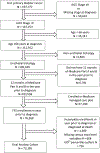Geriatric conditions and treatment burden following diagnosis of non-muscle- invasive bladder cancer in older adults: A population-based analysis
- PMID: 33972184
- PMCID: PMC8429195
- DOI: 10.1016/j.jgo.2021.04.005
Geriatric conditions and treatment burden following diagnosis of non-muscle- invasive bladder cancer in older adults: A population-based analysis
Abstract
Introduction: Treatment burden is emerging as an important patient-centered outcome for older adults with cancer who concurrently manage geriatric conditions. Our objective was to evaluate the contribution of geriatric conditions to treatment burden in older adults with non-muscle invasive bladder cancer (NMIBC).
Methods: We identified 73,395 Medicare beneficiaries age 66+ diagnosed with NMIBC (Stage <II) in SEER-Medicare (2001-2014). The primary outcome was treatment burden, defined as health system contact days in the year following NMIBC diagnosis. Explanatory variables were the following geriatric conditions: multimorbidity (≥ 2 chronic conditions), functional dependency, falls, depression, cognitive impairment, weight loss, and urinary incontinence. We used negative binomial regression to model the association between individual geriatric conditions and treatment burden while adjusting for covariates.
Results: At baseline, 64% had multimorbidity and median 3 conditions (IQR 0-5). Prevalence of other geriatric conditions ranged from 5.9%-15.2%. Adjusted mean health system contact was 8.9 days (95% CI 8.6-9.2). Multimorbidity had the largest effect size (adjusted mean 11.8 contact days (95% CI 8.3-8.8)). Each additional chronic condition conferred a 13% increased average number of health system contact (adjusted IRR 1.132, 95% CI 1.129-1.135). Regardless of number of chronic conditions, rural patients consistently had more treatment burden than urban counterparts.
Discussion: In this population-based cohort of older NMIBC patients, multimorbidity and rurality were strongly associated with treatment burden in the year following NMIBC diagnosis. These findings highlight the need for interventions that reduce treatment burden due to geriatric conditions among the growing population of older adults with cancer, particularly in rural areas.
Keywords: Bladder cancer; Geriatric oncology; Multimorbidity; Patient-centered outcomes; Rural disparities; Treatment burden.
Copyright © 2021 Elsevier Ltd. All rights reserved.
Conflict of interest statement
Declaration of Competing Interest Matthew E. Nielsen serves as a paid consultant to the American College of Physicians High Value Care Task Force and as a consultant/advisor to Grand Rounds for which he is paid via stock options. Tullika Garg served as a paid consultant to WebMD and reports an immediate family member is an employee of DRPLZ and is a stockholder. All other authors report no conflict of interest.
Figures



Comment in
-
Geriatrics.J Urol. 2022 Feb;207(2):443-446. doi: 10.1097/JU.0000000000002317. Epub 2021 Nov 16. J Urol. 2022. PMID: 34781702 No abstract available.
References
-
- Yabroff KR, Guy GP, Banegas MP, Ekwueme DU. The economic burden of cancer in the United States. Schottenfeld Fraumeni Cancer Epidemiol Prev Fourth Ed. 2017;35(18):169–182. doi:10.1093/oso/9780190238667.003.0010 - DOI
-
- National Comprehensive Cancer Network. Older Adult Oncology (Version 2.2020). Published2020. AccessedOctober 5, 2020. https://www.nccn.org/professionals/physician_gls/pdf/senior.pdf
Publication types
MeSH terms
Grants and funding
LinkOut - more resources
Full Text Sources
Other Literature Sources
Medical

